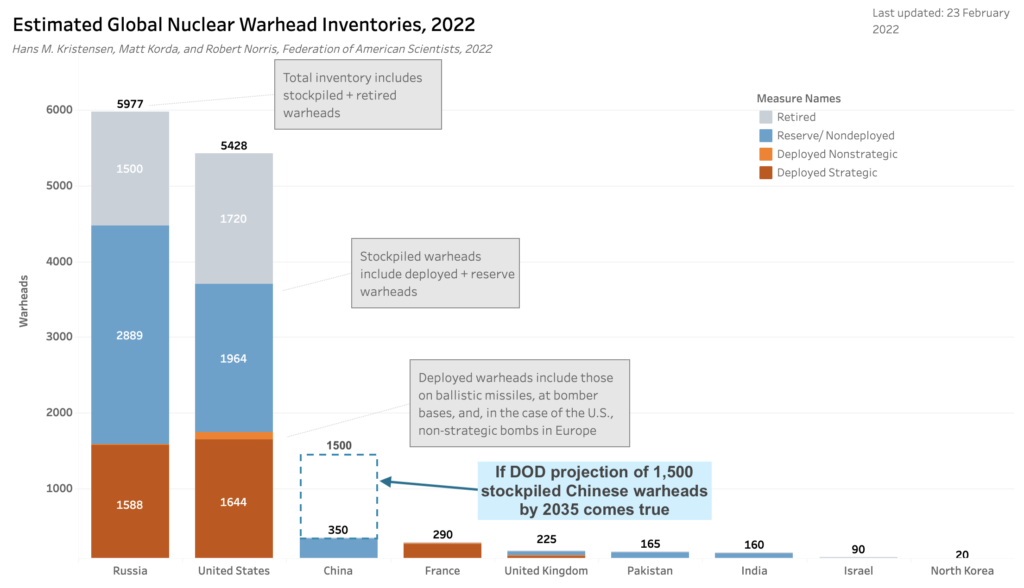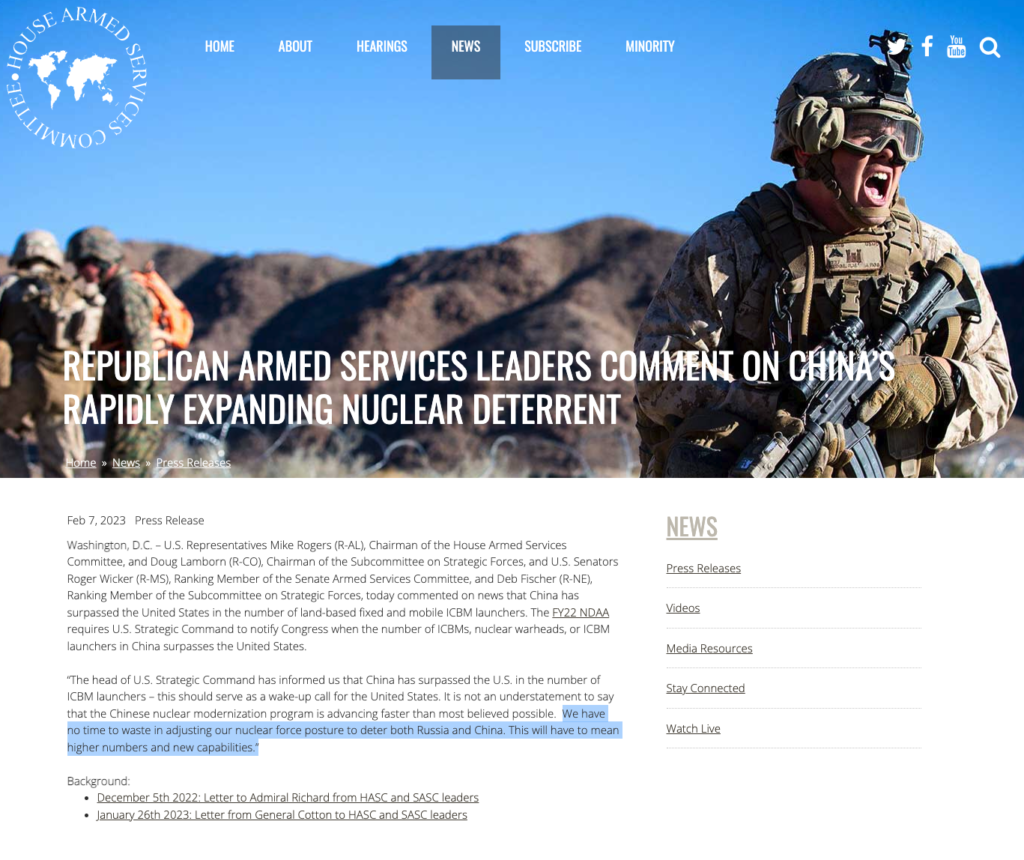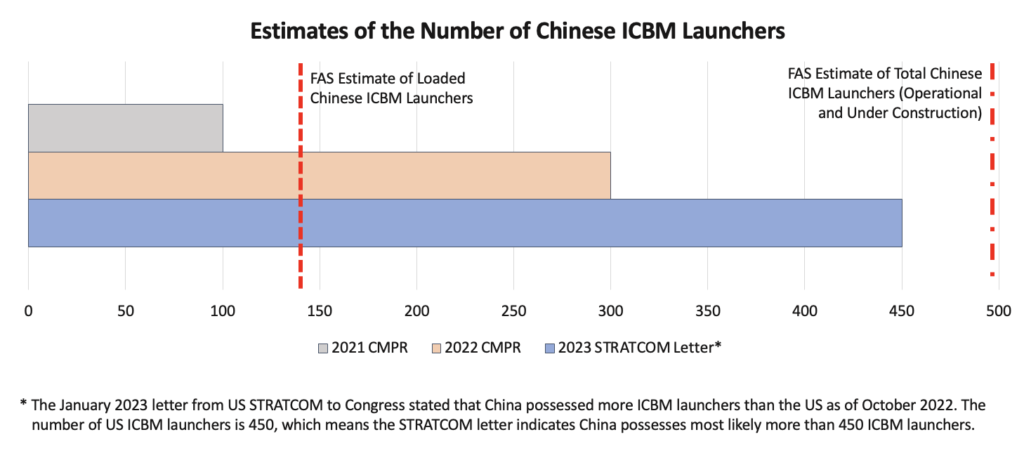| STRATCOM Says China Has More ICBM Launchers Than The United States – We Have Questions
美国战略司令部称中国拥有的洲际弹道导弹发射器比美国多——我们有疑问 Date:2023-03-04 Source:Fas By:Hans Kristensen, Elia Viewed: |
By Hans Kristensen, Eliana Reynolds and Matt Korda • February 10, 2023
作者:汉斯·克里斯滕森,伊莉亚娜·雷诺兹和马特·科尔达,2023年2月10日
In early-February 2023, the Wall Street Journal reported that U.S. Strategic Command (STRATCOM) had informed Congress that China now has more launchers for Intercontinental Ballistic Missiles (ICBMs) than the United States. The report is the latest in a serious of revelations over the past four years about China’s growing nuclear weapons arsenal and the deepening strategic competition between the world’s nuclear weapon states. It is important to monitor China’s developments to understand what it means for Chinese nuclear strategy and intensions, but it is also important to avoid overreactions and exaggerations.
2023年2月初,《华尔街日报》报道称,美国战略司令部(STRATCOM)已通知国会,中国现在拥有的洲际弹道导弹(ICBM)发射器数量超过美国。该报告是过去四年来有关中国不断增长的核武器库以及世界核武器国家之间不断深化的战略竞争的一系列披露中的最新一份。监控中国的发展,了解其对中国核战略和核意图的意义是很重要的,但避免过度反应和夸大也很重要。
First, a reminder about what the STRATCOM letter says and does not say. It does not say that China has more ICBMs or warheads on them than the United States, or that the United States is at an overall disadvantage. The letter has three findings (in that order):
首先,提醒一下战略司令部的报告中说了什么,没有说什么。它并没有说中国拥有比美国更多的洲际弹道导弹或弹头,也没有说美国处于总体劣势。这份报告有三个调查结果(按顺序):
●The number of ICBMs in the active inventory of China has not exceeded the number of ICBMs in the active inventory of the United States.
中国现役库存中的洲际弹道导弹数量尚未超过美国现役库存中洲际弹道导弹的数量。
●The number of nuclear warheads equipped on such missiles of China has not exceeded the number of nuclear warheads equipped on such missiles of the United States.
中国此类导弹上配备的核弹头数量尚未超过美国此类导弹上的核弹头数量。
●The number of land-based fixed and mobile ICBM launchers in China exceeds the number of ICBM launchers in the United States.
中国陆基固定和移动洲际弹道导弹发射器的数量超过了美国的洲际弹道导弹发射装置数量。
It is already well-known that China is building several hundred new missile silos. We documented many of them (see here, here and here), as did other analysts (here and here). It was expected that sooner or later some of them would be completed and bring China’s total number of ICBM launchers (silo and road-mobile) above the number of US ICBM launchers. That is what STRATCOM says has now happened.
众所周知,中国正在建造数百座新型导弹发射井。我们记录了它们中的许多成员(见这里、这里和这里),其他分析师也记录了它们(这里和这里。预计其中一些项目迟早会完工,使中国的洲际弹道导弹发射器(发射井和公路机动式)总数超过美国的洲际弹道弹道导弹发射器数量。这就是战略司令部所说的现在发生的事情。
STRATCOM ICBM Counting
战略司令部洲际弹道导弹数量统计
The number of Chinese ICBM launchers included in the STRATCOM report to Congress was counted at a cut-off date of October 2022. It is unclear precisely how STRATCOM counts the Chinese silos, but the number appears to include hundreds of silos that were not yet operational with missiles at the time. So, at what point in its construction process did STRATCOM include a silo as part of the count? Does it have to be completely finished with everything ready except a loaded missile?
向国会提交的战略报告中包含的中国洲际弹道导弹发射器的数量在2022年10月的截止日期计算。目前还不清楚战略司令部是如何计算中国的发射井的,但这个数字似乎包括数百个当时尚未使用导弹操作的发射井。那么,在其建设过程中,战略司令部在什么时候将一个筒仓作为计数的一部分呢?它必须完全完成,一切准备好吗?
We have examined satellite photos of every single silo under construction in the three new large missile silo fields (Hami, Julin, and Yumen). It is impossible to determine with certainty from a satellite photo if a silo is completely finished, much less whether it is loaded with a missile. However, the available images indicate it is possible that most of the silos at Hami might have been complete by October 2022, that many of the silos at the Yumen field were still under construction, and that none of the silos at the Julin (Ordos) fields had been completed at the time of STRATCOM’s cutoff date (see image below).
我们检查了三个新的大型导弹发射场(哈密、朱林和玉门)中每一个在建发射井的卫星照片。从卫星照片无法确定筒仓是否完全完工,更不用说是否装载了导弹。然而,现有图像表明,哈密的大部分筒仓可能在2022年10月前完工,玉门油田的许多筒仓仍在施工中,而在战略司令部截止日期时,朱林(鄂尔多斯)油田的所有筒仓均未完工(见下图)。
Commercial satellite images help assess STRATCOM claim about China’s missile silos.
商业卫星图像有助于评估战略司令部对中国导弹发射井的说法。
The number of Chinese ICBM launchers reported by the Pentagon over the past three years has increased significantly from 100 launchers at the end of 2020, to 300 launchers at the end of 2021, to now more than 450 launchers as of October 2022. That is an increase of 350 launchers in only three years.
五角大楼报告过去三年中,中国洲际弹道导弹发射器的数量大幅增加,从2020年底的100个发射器增加到2021年底的300个发射器,到2022年10月,目前已超过450个发射器。这意味着仅三年就增加了350个发射器。
To exceed the number of US ICBM launchers as most recently reported by STRATCOM, China would have to have more than 450 launchers (mobile and silo) – the US Air Force has 400 silos with missiles and another 50 empty silos that could be loaded as well if necessary. Without counting the new silos under construction, we estimate that China has approximately 140 operational ICBM launchers with as many missiles. To get to 300 launchers with as many missiles, as the 2022 China Military Power Report (CMPR) estimated, the Pentagon would have to include about 160 launchers from the new silo fields – half of all the silos – as not only finished but with missiles loaded in them. We have not yet seen a missile loading – training or otherwise – on any of the satellite photos. To reach 450 launchers as of October 2022, STRATCOM would have to count nearly all the silos in the three new missile silo fields (see graph below).
为了超过美国战略司令部最近报告的洲际弹道导弹发射器数量,中国必须拥有450多个发射器(机动式和发射井)——美国空军有400个发射井和另外50个空发射井,如果需要的话,也可以装载。在不计算正在建造的新发射井的情况下,我们估计中国大约有140个可操作的洲际弹道导弹发射器,其导弹数量与之相当。如《2022年中国军事力量报告》(CMPR)所估计,为了达到300个导弹发射装置,五角大楼必须包括来自新发射场的约160个发射装置——其中一半是发射井——不仅完成了发射,而且还装载了导弹。我们还没有在任何卫星照片上看到导弹装载——训练或其他方面。为了在2022年10月达到450个发射装置,战略司令部必须统计三个新导弹发射井场中几乎所有的发射井(见下图)。
Pentagon estimates of Chinese completed ICBM launchers appear to include hundreds of new silos at three missile silo fields.
五角大楼估计,中国完成的洲际弹道导弹发射器似乎包括三个导弹发射场的数百个新发射井。
The point at which a silo is loaded with a missile depends not only on the silo itself but also on the operational status of support facilities, command and control systems, and security perimeters. Construction of that infrastructure is still ongoing at all the three missile silo fields.
发射井装载导弹的位置不仅取决于发射井本身,还取决于支持设施、指挥和控制系统以及安全周边的运行状态。这三个导弹发射场的基础设施建设仍在继续。
It is also possible that the number of launchers and missiles in the Pentagon estimate is less directly linked. The number could potentially refer to the number of missiles for operational launchers plus missiles produced for launchers that have been more or less completed but not yet loaded with missiles.
也有可能是五角大楼估计的发射器和导弹的数量没有那么直接的联系。这个数字可能是指用于作战发射器的导弹数量,以及为或多或少已经完成但尚未装载导弹的发射器生产的导弹数量。
All of that to underscore that there is considerable uncertainty about the operational status of the Chinese ICBM force.
所有这些都强调了中国洲际弹道导弹部队的作战状态存在相当大的不确定性。
However – in time for the Congressional debate on the FY2024 defense budget – some appear to be using the STRATCOM letter to suggest the United States also needs to increase its nuclear arsenal.
然而 – 在国会就2024财年国防预算进行辩论的时候,一些人似乎在利用战略司令部的报告暗示美国也需要增加核武库。
Comparing The Full Arsenals
比较完整的武库
The rapid increase of the Chinese ICBM force is important and unprecedented. Yet, it is also crucial to keep things in perspective. In his response to the STRATCOM letter, Rep. Mike Rogers – the new conservative chairman of the House Armed Services Committee – claimed that China is “rapidly approaching parity with the United States” in nuclear forces. That is not accurate.
中国洲际弹道导弹(ICBM)力量的迅速增长是重要的,也是前所未有的。然而,保持正确的观点也是至关重要的。众议院军事委员会新任保守派主席、众议员迈克·罗杰斯(Mike Rogers)在回应战略司令部的报告时声称,中国在核力量方面“正在迅速接近与美国的对等地位”。这并不准确。
Even if China ends up with more ICBMs than the United States and increases its nuclear stockpile to 1,500 warheads by 2035, as projected by the Pentagon, that does not give China parity. The United States has 800 launchers for strategic nuclear weapons and a stockpile of 3,700 warheads (see graph below).
即使中国最终拥有比美国更多的洲际弹道导弹,并按照五角大楼的预测,到2035年将其核储备增加到1500枚弹头,但这并不能使中国获得同等地位。美国拥有800个战略核武器发射器和3700枚弹头(见下图)。

Even if China increases it nuclear weapons stockpile to 1,500 by 2035, it will only make up a fraction of the much larger US and Russian stockpiles.
即使中国到2035年将其核武器储备增加到1500枚,也只占美国和俄罗斯更大库存的一小部分。
The worst-case projection about China’s nuclear expansion assumes that it will fill everything with missiles with multiple warheads. In reality, it is unknown how many of the new silos will be filled with missiles, how many warheads each missile will carry, and how many warheads China can actually produce over the next decade.
关于中国核扩张的最坏预测是,它将用多弹头的导弹填满一切。事实上,还不知道有多少新发射井将装满导弹,每枚导弹将携带多少弹头,以及中国在未来十年内实际能生产多少弹头。
The nuclear arsenals do not exist in a vacuum but are linked to the overall military capabilities and the policies and strategies of the owners.
核武库不是在真空中存在的,而是与整体军事能力和所有者的政策和战略有关。
The Political Dimension
政治层面
STRATCOM initially informed Congress about its assessment that the number of Chinese ICBM launchers exceeded that of the United States back in November 2022. But the letter was classified, so four conservative members of the Senate and House armed services committees reminded STRATCOM that it was required to also release an unclassified version. They then used the unclassified letter to argue for more nuclear weapons stating (see screen shot of Committee web page below):
战略司令部最初在2022年11月向国会通报了其对中国洲际弹道导弹发射器数量超过美国的评估。但这份报告是保密的,因此参议院和众议院军事委员会的四名保守派成员提醒战略司令部,它还需要发布一份非保密版本。然后,他们用这封非保密报告主张增加核武器数量(见委员会网页截图):
“We have no time to waste in adjusting our nuclear force posture to deter both Russia and China. This will have to mean higher numbers and new capabilities.” (Emphasis added.)
“我们没有时间浪费在调整我们的核力量态势上,以威慑俄罗斯和中国。这将意味着更高的数量和新的能力。”(强调补充道)

Lawmakers immediately used STRATCOM assessment of Chinese ICBM launchers to call for more US nuclear weapons.
议员们立即利用战略司令部对中国洲际弹道导弹发射器的评估,呼吁美国制造更多核武器。
Although defense contractors probably would be happy about that response, it is less clear why ‘higher numbers’ are necessary for US nuclear strategy. Increasing US nuclear weapons could in fact end up worsening the problem by causing China and Russia to increase their arsenals even further. And as we have already seen, that would likely cause a heightened demand for more US nuclear weapons.
尽管国防承包商可能会对这种反应感到高兴,但对于美国的核战略为什么需要“更高的数字”,目前还不太清楚。事实上,增加美国的核武器可能会导致中国和俄罗斯进一步增加核武库,从而导致问题恶化。正如我们已经看到的那样,这可能会导致美国对更多核武器的需求增加。
We have seen this playbook before during the Cold War nuclear arms race. Only this time, it’s not just between the United States and the Soviet Union, but with Russia and a growing China.
我们以前在冷战核军备竞赛期间看过这本剧本。只是这一次,这不仅仅是在美国和苏联之间,而是在俄罗斯和一个不断发展的中国之间。
Even before China will reach the force levels projected by the Pentagon, the last remaining arms control treaty with Russia – the New START Treaty – will expire in February 2026. Without a follow-on agreement, Russia could potentially double the number of warheads it deploys on its strategic launchers.
甚至在中国达到五角大楼预计的兵力水平之前,与俄罗斯签订的最后一项军备控制条约——《新削减战略武器条约》——将于2026年2月到期。如果没有后续协议,俄罗斯可能会将部署在其战略发射器上的弹头数量增加一倍。
Even if the defense hawks in Congress have their way, the United States does not seem to be in a position to compete in a nuclear arms race with both Russia and China. The modernization program is already overwhelmed with little room for expansion, and the warhead production capacity will not be able to produce large numbers of additional nuclear weapons for the foreseeable future.
即使国会中的国防鹰派各行其是,美国似乎也无法与俄罗斯和中国进行核军备竞赛。现代化计划已经不堪重负,几乎没有扩张的空间,在可预见的未来,弹头生产能力将无法生产大量额外的核武器。
What the Chinese nuclear buildup means for Chinese nuclear policy and how the United States should respond to it (as well as to Russia) is much more complicated and important to address than a rush to get more nuclear weapons. It would be more constructive for the United States to focus on engaging with Russia and China on nuclear risk reduction and arms control rather than engage in a build-up of its nuclear forces.
中国的核建设对中国的核政策意味着什么,以及美国应该如何应对(以及俄罗斯),要比急于获得更多核武器更加复杂和重要得多。对美国来说,专注于与俄罗斯和中国在减少核风险和军备控制方面进行接触,而不是加强其核力量,将更有建设性。
Additional Information:
附加信息:
Status of World Nuclear Forces
世界核力量的现状
This research was carried out with generous contributions from the John D. and Catherine T. MacArthur Foundation, the New-Land Foundation, Ploughshares Fund, the Prospect Hill Foundation, the FTX Future Fund and Longview Philanthropy, the Stewart R. Mott Foundation, the Future of Life Institute, Open Philanthropy, and individual donors.
这项研究是在约翰·D·和凯瑟琳·T·麦克阿瑟基金会、新土地基金会、犁铧基金会、展望山基金会、FTX未来基金会和朗维尤慈善基金会、斯图尔特·R·莫特基金会、生命未来研究所、开放慈善事业和个人捐助者的慷慨捐助下进行的。
Categories: Arms Control, China, ICBM, Nuclear Weapons, Russia, United States
类别:军备控制,中国,洲际弹道导弹,核武器,俄罗斯,美国
上一篇:Countries urge action for rules on AI use in war 下一篇:Seabed warfare is a ‘real and present threat’
| The Booker dilemma: inside US Army transformation
“布克”困境:美国陆军转型内幕 |
| The decision to cancel the M10 Booker light tank is at the core of a reordering of US Army planning.... [2025-07-16] |
| Focus: A fragile balance in Asia, China has become leading military power in the
焦点:亚洲平衡脆弱,中国已成为该地区的主要军事力量 |
| However, China's rapid military growth in this area is tipping the balance in favor of regional power. ... [2024-08-27] |
| Small drones will soon lose combat advantage, French Army chief says
法国陆军总司令表示,小型无人机将很快失去战斗优势 |
| By Rudy Ruitenberg Thursday, Jun 20, 2024 作者:鲁迪瑞滕伯格 2024年6月20日星期四 French Army Chief of Staff Gen. Pierre Schill inspecting a Rapid Eagle anti-drone system at the Eurosatory defense show in Paris on June 19, 202... [2024-08-18] |
| What’s next for Ukraine’s incursion into Russia?
乌克兰入侵俄罗斯的下一步是什么? |
| Ukraine’s forces have surprised us all with its recent incursion into Russia’s Kursk Oblast since the operation to turn the tide of the war,... [2024-08-17] |


